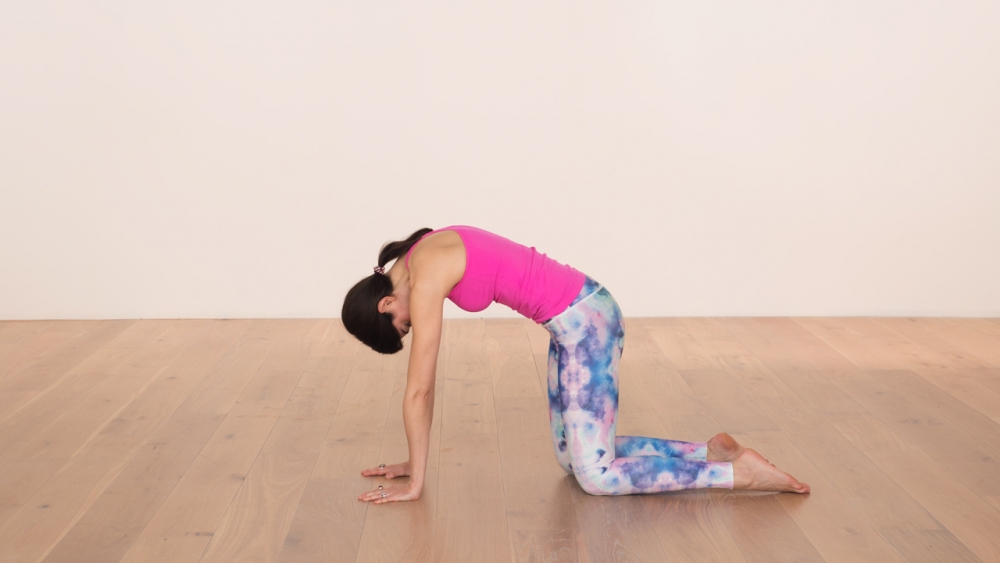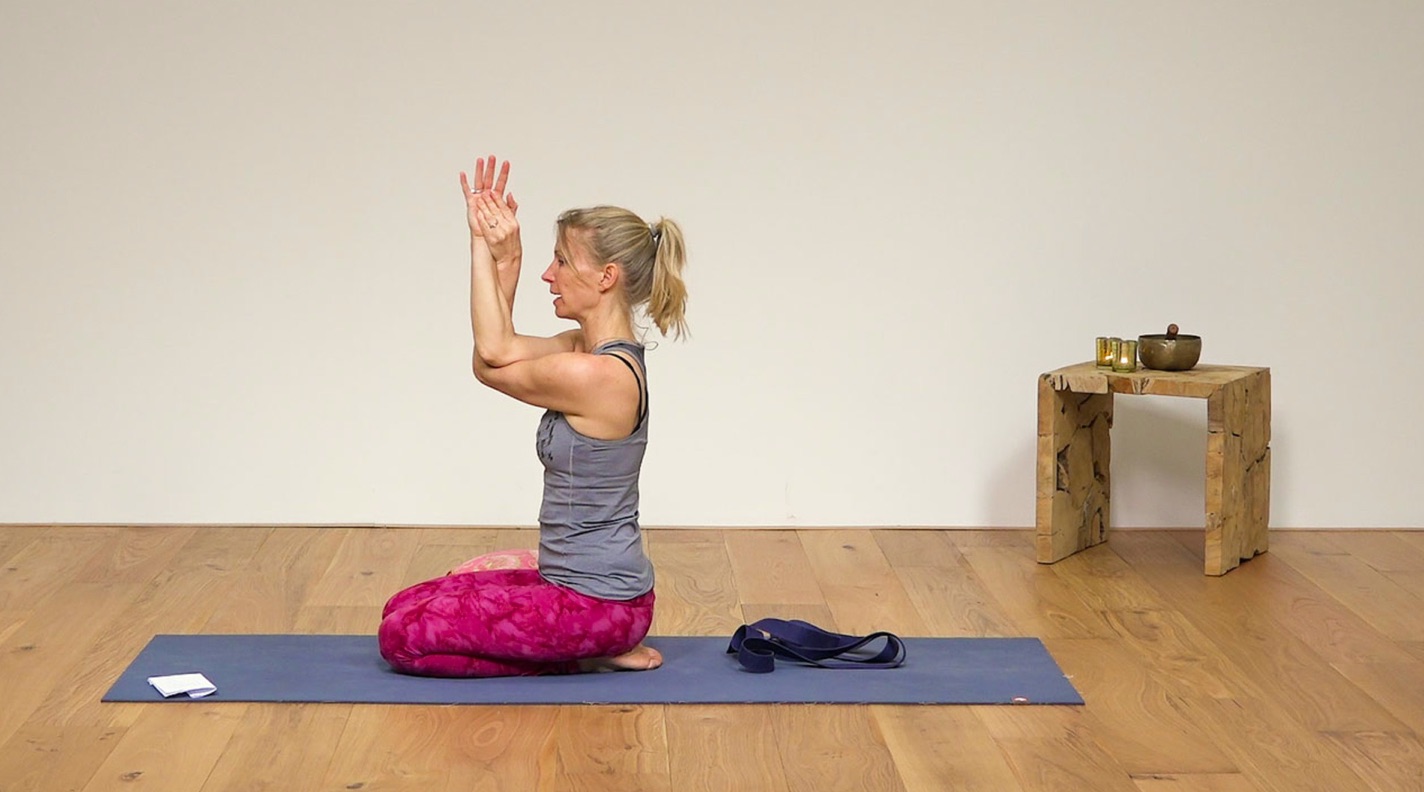Over the past couple of articles in this series, we’ve been working our way up the spine, looking at its structure and its role in our yoga practice. Now it’s time to move up a little further to the upper back – the thoracic spine.
Extending and expanding in the heart space
I love the upper back. Its importance is often overlooked because I think we place more value on the ‘weight-bearing’ role that the lower back plays. And also, because the lumbar spine is directly connected to our legs, we tend to really know about it when it’s unhappy. Whereas, if we’ve got a less-mobile upper back, we can manoeuvre ourselves around it a little more surreptitiously.
The thoracic vertebrae are the attachments for our ribs, home to our far-reaching heart and our fabulous lungs. The nerves that supply all of the internal organs emerge from the thoracic vertebrae, so it has quite a significant responsibility to deliver its goods!
Find freedom in your upper back in this class with Esther Ekhart and then read on for a simple 5-minutes-a-day exercise:
Increase your shoulder and upper back mobility
Concave, convex and concave again
Our spine is shaped like one-and-a-half S’s. It starts as a concave curve at the lumbar spine, changes direction at the convex thoracic region and then the cervical spine (neck) forms another concave curve.
This convex curve of the thoracic spine is what can sometimes put us in a pickle, not least when we spend a lot of time sitting.
Sitting in a chair with a nice comfy backrest allows us to slump. It just makes that rounded, more flexed shape of our upper back easier to sink into. Which we will inevitably do, and which is fine…unless we forget to move into the opposite direction regularly and extend into our thoracic spine!
- A quick reminder: Flexion in the spine is where we round the spine like in Cat pose. Extension in the spine is what we do in backbends like Cow pose.
Fortunately, there are numerous yoga poses to extend our upper back – with sphinx, cobra, upward facing dog, cow pose and camel just to name a few.
But this generous array of postures doesn’t necessarily make it any easier for us initially, especially if we’re already habituated to a more forward flexed position through our upper back because of our daily habits (desk work and so on). What’s more, if we don’t have access to the full range of movement through our upper back and we take this more ‘kyphotic’ shape of the thoracic spine (which charmingly comes from the Greek word for hump), it will also affect our shoulder mobility.
The last 20 degrees of raising our arms above our heads is generated from the extension (back bend) in the thoracic spine – try it out:
The upper back and shoulder mobility test
Stand up and slump your shoulders and head forwards. Then, try and raise your arms in front of you, without moving your back, and see how far you get. Your arms will probably get stuck at around level with your nose – and you’ll still be looking at the floor if you’re playing the game correctly!
Then start again. This time, stand up straight and then raise your arms. Allow your back to move naturally. You’ll notice how your upper spine opens you up so that you can take your arms all the way over your head – or at least a lot closer… Nice hey?
Our biggest breath
This extension in the upper back has significant ramifications not just for this shoulder movement, but also for accessing our fullest breath.
Although our ribs are attached to the thoracic vertebrae fairly firmly via cartilage, they still require mobility. Exercising the ability to expand the muscles in-between our ribs (our ‘intercostal’ muscles) allows us to take a broader, more full breath. And in turn, this requires the thoracic vertebra to have freedom and flexibility. In our yoga classes, this translates into breathing in ‘the back of the body’.
We also talked about the breath in the previous article about the waist, and how the interplay of the 3 diaphragms is so important to generate quality breathing. When we’ve been exerting ourselves and need to take a bigger breath, the ribs will want to be able to broaden to allow a greater volume of air to enter. The upper part of our chest will also expand.
It is the thoracic outlet (the musculature over the top of the lungs) which fires into action to help our lungs fill with a ‘bigger breath’. Our thoracic outlet kicks in to generate a larger space for our lungs to occupy. Stiffness in the vertebrae at the top of the thoracic spine and the ribs will prevent us from taking our most full breath.
When we’re more curved in our upper spine, this also puts our upper shoulder muscles on a stretch and part of the issue here is with the fascia, once again.
Fascia contracts around the postures that we adopt the most often. It’s slow to take grip around the musculature…and therefore also slow to let go. If we’re ‘round-shouldered’ (read: more curved in the upper back), then the fascia is holding us there.
An easy exercise for upper back mobility
So where to start if your upper back mobility warrants a spot of attention?
Well, I’m a big fan of a simple, relaxing posture that I call, ‘lying over a rolled-up hand towel’ and it goes like this:
You’ll need a smallish towel – roll it up into a sausage shape and put it by the side of your mat.
Start off lying down on your mat. Place your feet on the mat, lift and lower your hips, so that your lower back is comfortable.
Straighten your legs out again if that’s ok for your body, or keep them bent.
Make sure that your neck is comfortably ‘long’. Use a small pillow if you need one.
And then simply breathe and check in with how this feels for you…this is your benchmark.
Then, take your towel and place it lengthways under your spine between your shoulder blades, so that it starts at the base of your neck and sits halfway down your back.
You may still rest your head on something but make sure it is not too high so that your neck muscles can get to relax too. You can also bend your knees again if you wish and manoeuvre your lower back so that it’s happy too. Comfort is king – even if lying with a towel between your shoulder blades is about as far from comfortable as you could possibly be right now!
Then take a deep breath in, and with the exhale, allow your shoulders to sink down towards the floor. Spend 3 – 5 minutes here. You’ll gradually soften into the ‘awkwardness’, and your shoulders will relax more and more towards the floor.
When you’re ready, take away the towel but go back to lying down once again for a moment, to be able to compare and register the experience in your body afterwards.
Perhaps you’ll feel more spacious, lighter maybe, more open and broader across the back? Try standing up – how does that experience translate into an upright position – do you still feel more expansive and open? Taller perhaps, slightly?
What we’ve done by elevating your upper spine away from the floor is to create some ‘space’. Some space so that your shoulders and their muscles can relax, as can your neck muscles.
We’re also giving the fascia the sits over the back of our shoulder and upper back region the opportunity to release, even if just a little bit.
My experience with this exercise in the physio clinic is that it has a significant, positive effect of the space within the upper back, not least because we’ve just given it lots and lots of different sensory input. And this initial mobility in the upper back is a great place to start for all of those heart-opening – back bend postures.
Try it for 5 minutes each day and notice the change that occurs not only in your yoga but also in your day!
More from Dawn’s Anatomy series:
- Anatomy of the spine – the lower back
- Anatomy of the spine – connected by the waist
- Anatomy of the spine – the neck
About the author:
Dawn Meredith-Davies MSc is a holistic physiotherapist, yoga teacher and writer. Having practised yoga for over 15 years, Dawn incorporates this in her clinic work together with hands-on treatment, acupuncture, nutrition and the all-important breath.
When she’s not on the mat, getting outdoors and running is Dawn’s mainstay. As a specialist in movement analysis for running, Dawn brings together all of these tools, as well her professional practice, her love of writing and sharing the good stuff at her Living Green Health website to help you run, breathe and live green!


